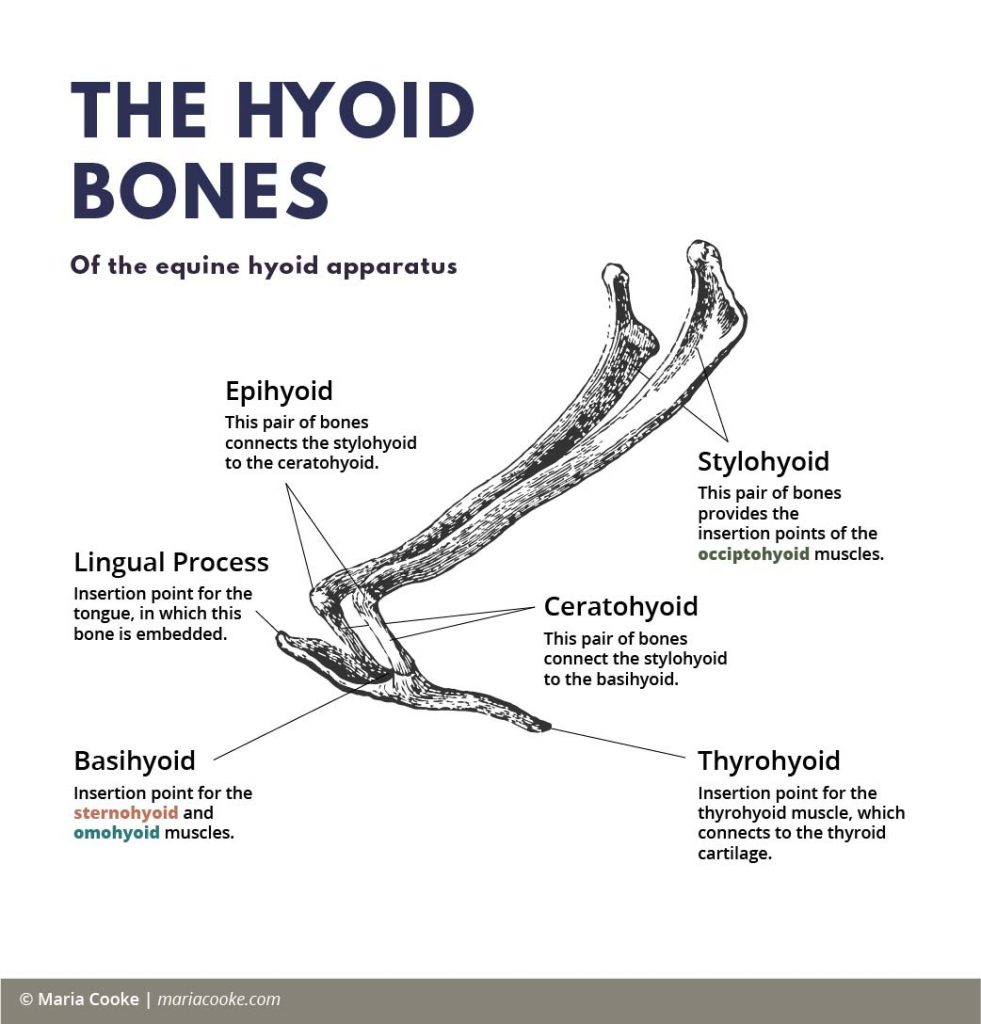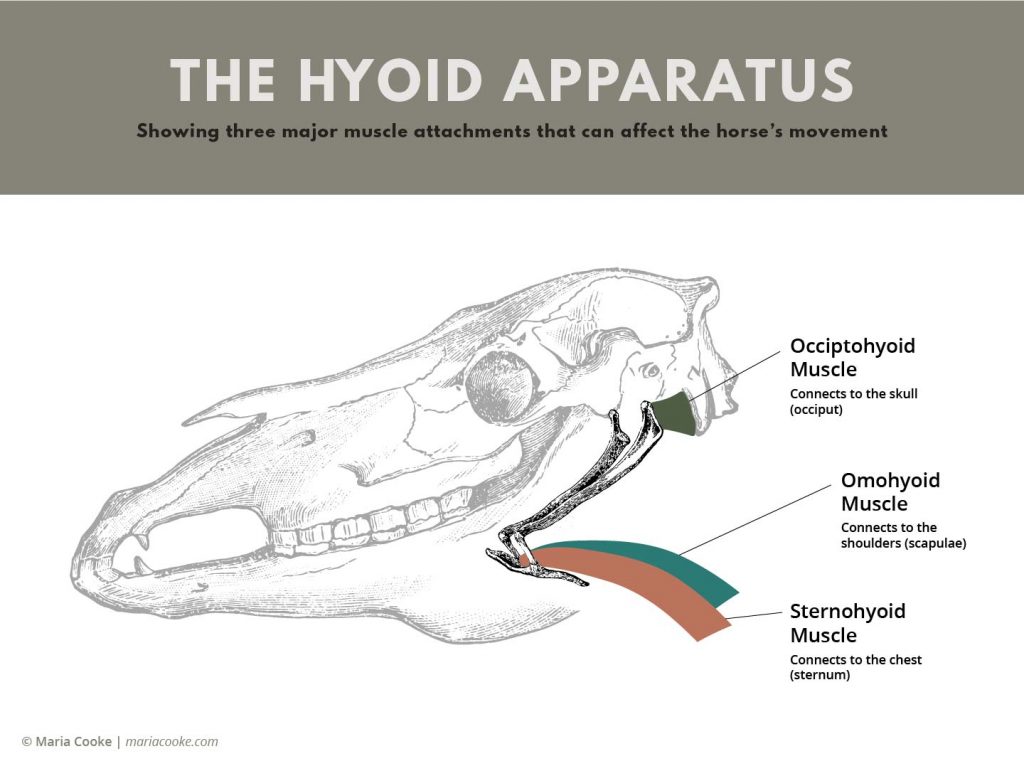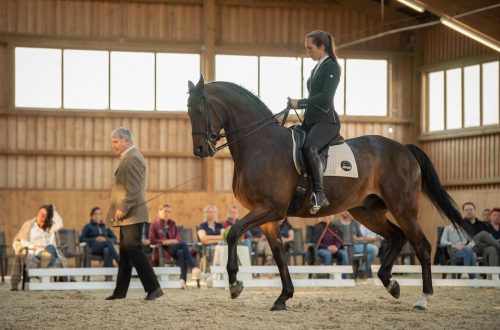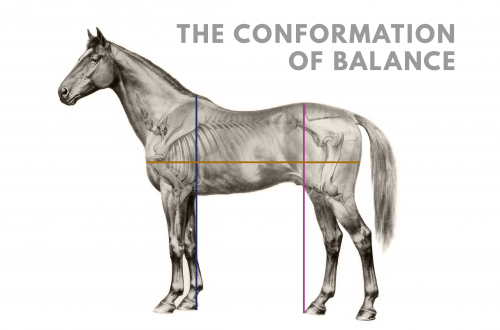
The Benefit of Using Bits | The Hyoid Connection
A well-trained horse with a skilled rider can often perform some of the most complex movements without saddle or bridle, their skill surpassing any need for specific equipment. Riders like Alizée Froment demonstrate exactly this – that communication depends on the skill of horse and rider much more than on any specific tools. And with increasing interest in bitless riding in recent years, some of us might wonder; why should we use bits anyways?
Bits are incredibly useful tools. From beginning a young horse to schooling higher level movements, they give us access to key biomechanical pathways in the horse. They are not simply for applying pressure to get a horse to comply! And as with any tool, their usefulness is determined by the knowledge, skill, and tact of the hands that guide them. While there are many ways we can communicate with and train a horse, by choosing to use a bit we can uniquely and precisely act on the mouth to affect pathways throughout the rest of the horse.
The key benefits of using bits are that:
- They allow us to communicate in a highly precise way, and
- When used knowledgeably, they can allow us to affect and improve the horse’s movement, and release tension in the horse’s body.
…How? Through the hyoid connection.
The Hyoid Connection
At the centre of this connection is the hyoid apparatus. Located at the base of the horse’s jaw, the hyoid bone acts as the attachment point for the tongue, and for 3 significant muscle and fascial chains that extend directly to the chest, shoulders, and poll, and indirectly to the abdominal muscles, neck, back, pelvis, and hind legs of the horse. It is the core touchpoint that connects together the main muscle and fascial chains of the rest of the horse’s body.
If we look at these key pathways in more detail, we can begin to see how significant the tongue and mouth can be in influencing the shoulders, forelimbs, abdominals, and hindquarters:
1. Connecting the Mouth to the Chest
The sternohyoid and sternothyroid muscles connect the mouth and tongue of the horse via the hyoid (and thyroid cartilage) to its chest (sternum). From this point, muscles and fascia continue this connection through the pectoral, and along the abdominal muscles on the underside on the horse, which extend into the pelvis. This contributes to the ventral chain between the mouth, chest and abdominals, that are key for lifting the forehand and lowering the hind end.
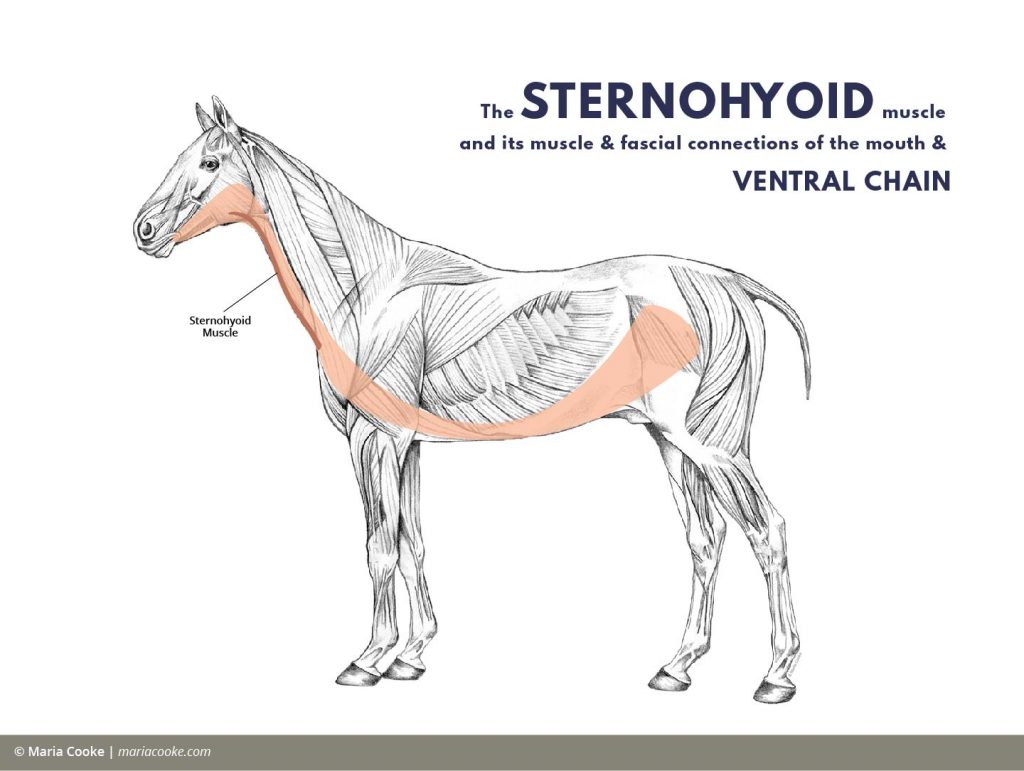
2. Connecting the Mouth to the Shoulders, Forelimbs, and Hindlegs
The omohyoid and omothyroid muscles, meanwhile, connect the hyoid to the shoulders at the shoulder blade (omohyoid) and top of the forelimbs (omothyroid), with connecting muscles and fascia continuing along the lower sides of the horse and down the hind legs, terminating at the toe. This creates a chain connecting the horse’s mouth to its shoulders, forelegs, and hind legs, whose freedom is key for proper movement.
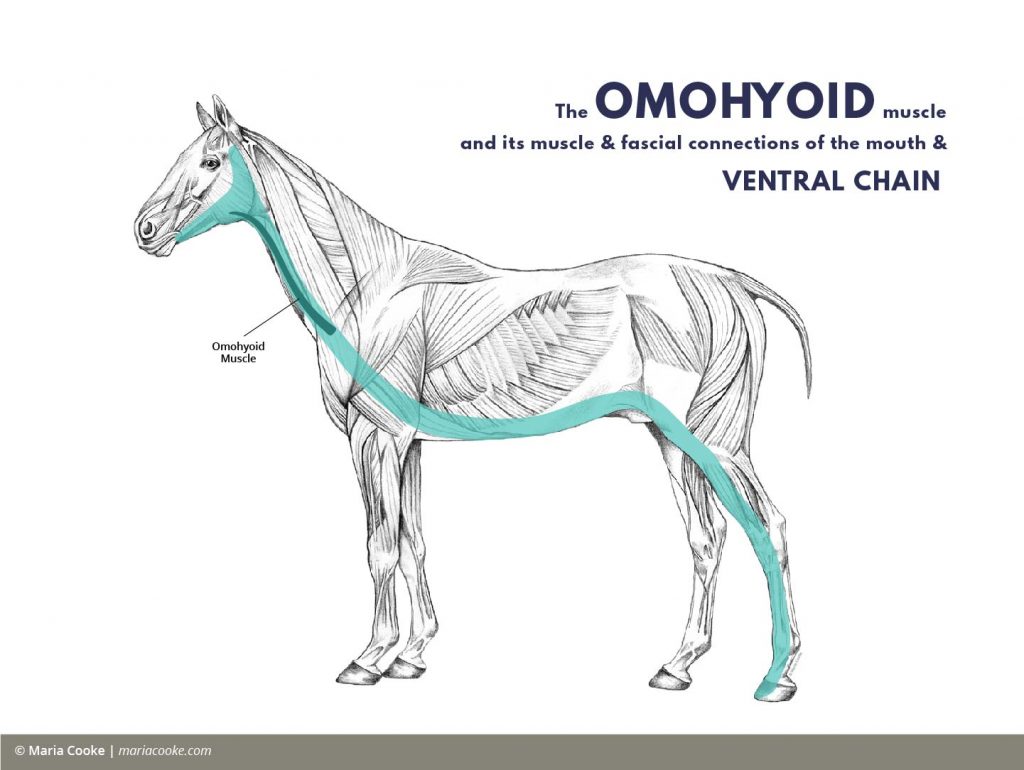
3. Connecting the Mouth to the Shoulders, Poll, Neck, Back, and Hindquarters
Different from the previous connections, the occiptohyoid muscle connects the hyoid up through to the poll (occiput) of the horse. The nuchal ligament then continues the connection from the poll down the neck, through the back (dorsal) muscles of the horse, and down the hindquarters. This chain connects the mouth with the poll, neck, back, and hindquarters, contributing to the horse’s unique “outline.”
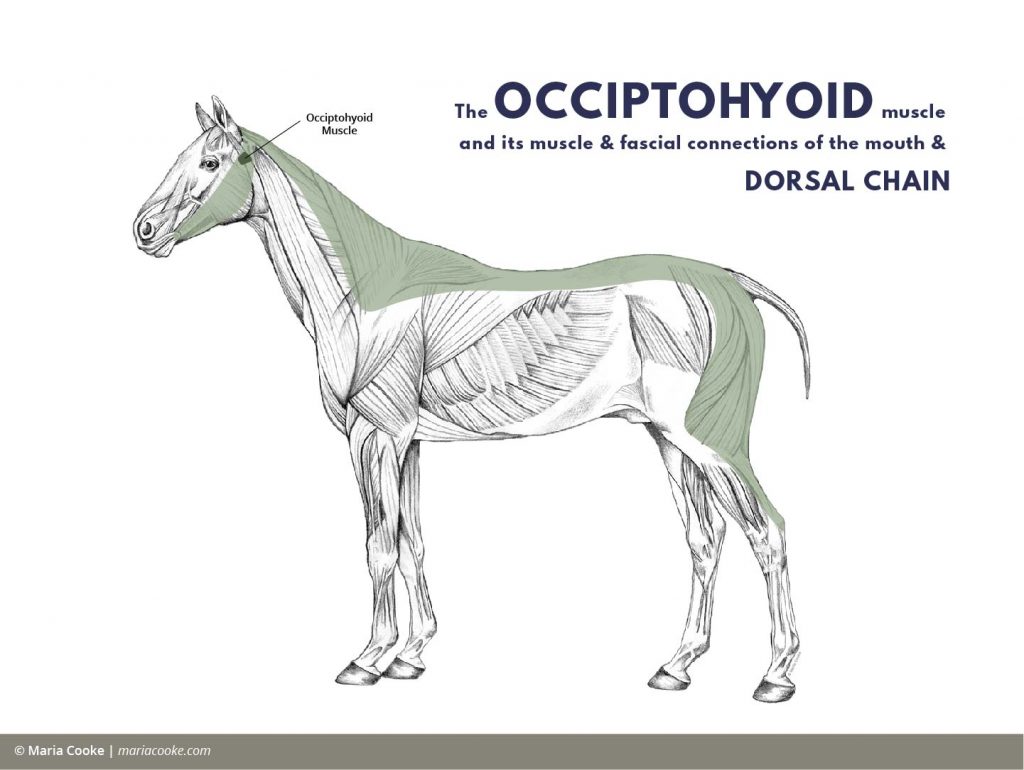
The Hyoid Connection and Movement
When we use a bit, there are muscular and fascial connections between our hands and the rest of the horse. This is enormously helpful if we learn how to use bits to influence and improve the horse’s movement, and work with this connection with great tact. For example, the flexions of Francois Baucher, and some in-hand exercises of classical dressage are designed to supple the jaw and neck in this way to enable the rest of the body to move freely.
The direct connections from the tongue and hyoid to the shoulders and forelimbs, and the indirect connections to the hindlegs, hindquarters, back, and abdominals indicate that if there is restriction in the hyoid, such as due to tension or restriction in the mouth, tongue, or jaw, the myofascial (muscle and fascia) networks extending from the hyoid may be compromised.
This means that tension and restriction in the jaw and mouth could impact the horse’s ability to freely move its shoulders, properly use all four limbs in extended and lateral work, and engage its back and haunches for collected work.
Susan Harris, who has spent decades studying the movement of horses, notes that:
“A stiff poll and jaw, holding behind the vertical or a rider that hangs on to the reins can inhibit the engagement of the ventral muscle chain and therefore the hindlimb. This is why over-bending to the inside or pulling on the reins can inhibit hindlimb engagement.”
Susan Harris | Horses Gaits, Balance and Movement: The Natural Mechanics of Movement Common to All Breeds
Veterinarian Dr. Megan Kelly in Cape Town, South Africa also explains that:
“… a restriction, pain or any dysfunction in the hyoid may have a direct impact on the mobility of the forelimb, leading to a possibly shortened or stilted gait. This can be transferred to the hindquarter as an inability to engage the hindlimbs. So we see that the hyoid and the tongue affects movement of the head, poll, and jaw, and also of the forelimb. Indirectly it connects to the hindlimb as well, through muscular chains and through the fascia.We can expect to see many areas affected by dysfunction in the hyoid bone, including the ability to perform lateral movement, the range of motion of the cervical spine, tension in the ventral muscles of the neck (and a tendency for the horse to go behind the bit to relieve that tension), a potentially hollow back and a shortened, stilted stride.”
Megan Kelly, DVM | OnlinePetHealth
So, how can we use bits to improve the horse’s movement?
Using the Bit to Improve Movement
The work of Baucher teaches us that contractions in the horse’s body can hinder its entire development, balance, and its quality of movement, and that issues and limitations of the horse often stem from tensions in the jaw and neck – the key touchpoint for the rest of the body.
Baucher explains in A New Method of Horsemanship that the individual conformation of each horse predisposes certain areas of its body to strength or weakness, stiffness or flexibility. This unequal arrangement, he says, is what underpins most issues with developing quality movements and balance.
“Long and conscientious observations have shown me that, whatever be the fault of formation that in the horse prevents a just distribution of his forces, it is always in the neck that the most immediate effect is felt. There is no improper movement, no resistance that is not preceded by the contraction of this part of the animal; and as the jaw is intimately connected with the neck, the stiffness of the one is instantly communicated to the other.”
François Baucher | A New Method of Horsemanship
Using specific flexions to release tension in the jaw, tongue, and neck is a good example of how we can use the bit to help the horse improve its physical development and movements, by evening out natural asymmetries, and supplying the whole body.
Essentially, using the bit allows us to access and influence the hyoid apparatus. By communicating directly with the mouth and tongue, we have the opportunity to influence the rest of the body through chains of muscles and fascia in a way we would not be able to otherwise.
Skill is always the more important factor over whatever equipment we choose to use, and while riding bitless can certainly be an excellent option, let us not forget what bits can help us do! When it comes to giving precise aids to help supple and balance a horse, using a bit knowledgeably gives us a unique opportunity to affect the whole horse through key biomechanical pathways, and help the horse progress.
__________________________________
Some sources for further reading:
The Equine Hyoid Apparatus | Vet Physio Phyle
The Role of the Tongue and Hyoid in Equine Movement | Online Pet Health
Inside your Horse’s Mouth | Horse Bit Fit (helpful diagrams here)


